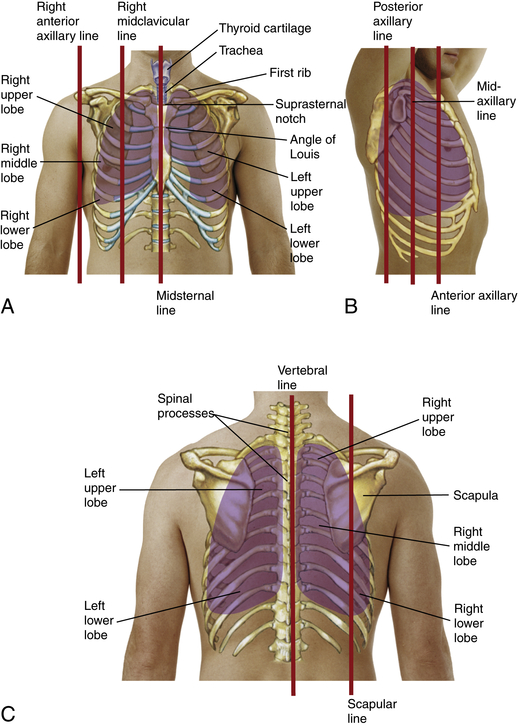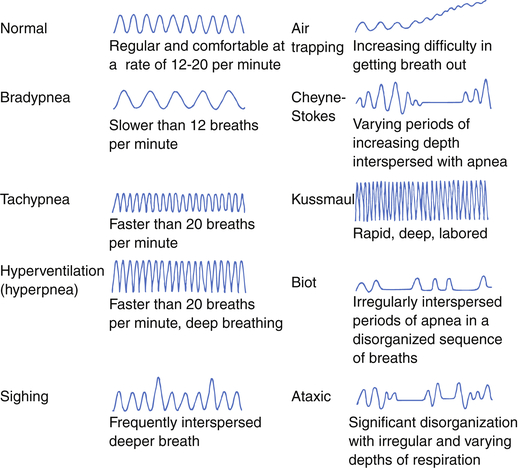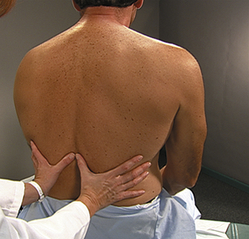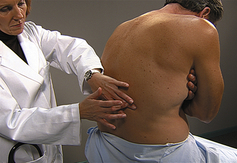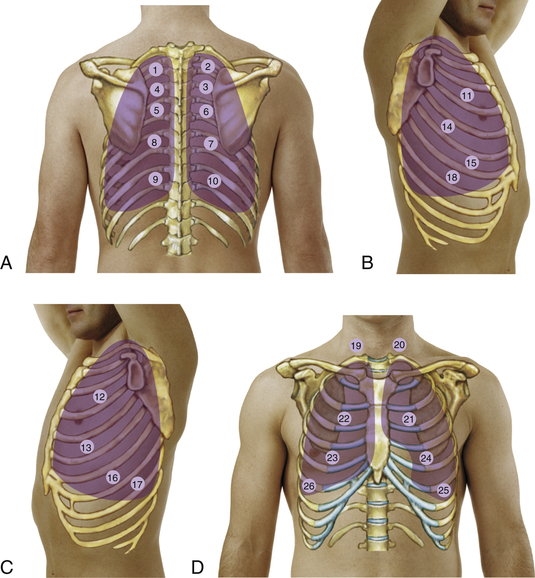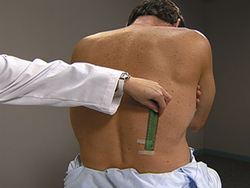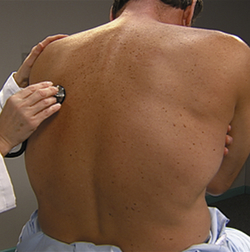Chest and Lungs
Examination
Have patient sit, disrobed to waist.
| Technique | Findings |
| Chest and Lungs | |
| Inspect front and back of chest | |
| See thoracic landmarks. | |
| EXPECTED: Supernumerary nipples possible (can be clue to other congenital abnormalities, particularly in white individuals). | |
| EXPECTED: Ribs prominent, clavicles prominent superiorly, sternum usually flat and free of abundance of overlying tissue. Chest somewhat asymmetric. Anteroposterior diameter often half of transverse diameter. | |
| UNEXPECTED: Barrel chest, posterior or lateral deviation, pigeon chest, or funnel chest. | |
| UNEXPECTED: Clubbed fingernails (usually symmetric and painless; may indicate disease, may be hereditary), pursed lips, flared alae nasi. | |
| UNEXPECTED: Superficial venous patterns. Cyanosis or pallor of lips or nails. | |
| UNEXPECTED: Malodorous. | |
| Evaluate respirations | |
| EXPECTED: Breathing easy, regular, without distress. Pattern even. Rate 12-20 respirations/min. Ratio of respirations to heartbeats about 1:4. | |
| UNEXPECTED: Dyspnea, orthopnea, paroxysmal nocturnal dyspnea, platypnea, tachypnea, hypopnea. Use of accessory muscles, retractions. | |
| UNEXPECTED: Air trapping, prolonged expiration. | |
| Inspect chest movement with breathing | |
| EXPECTED: Chest expansion bilaterally symmetric. | |
| UNEXPECTED: Asymmetry. Unilateral or bilateral bulging. Bulging on expiration. | |
| Listen to respiration sounds audible without stethoscope | |
| EXPECTED: Generally bronchovesicular. | |
| UNEXPECTED: Crepitus, stridor, wheezes. | |
| Palpate thoracic muscles and skeleton | |
| EXPECTED: Bilateral symmetry. Some elasticity of rib cage, but sternum and xiphoid relatively inflexible and thoracic spine rigid. | |
| UNEXPECTED: Pulsations, tenderness, bulges, depressions, unusual movement, unusual positions. | |
|
Stand behind patient. Place palms in light contact with posterolateral surfaces and thumbs along spinal processes at tenth rib, as shown in figure at right. Watch thumb divergence during quiet and deep breathing. Face patient; place thumbs along costal margin and xiphoid process with palms touching anterolateral chest. Watch thumb divergence during quiet and deep breathing. |
EXPECTED: Symmetric expansion. |
| UNEXPECTED: Asymmetric expansion. | |
| EXPECTED: Nontender sensations. | |
| UNEXPECTED: Crepitus or grating vibration. | |
| EXPECTED: Great variability; generally, fremitus is more intense with males (lower-pitched voice). UNEXPECTED: Decreased or absent fremitus; increased fremitus (coarser, rougher); or gentle, more tremulous fremitus. Variation between similar positions on right and left thorax. |
|
| Note position of trachea | |
| Using index finger or thumbs, palpate gently from suprasternal notch along upper edges of each clavicle and in spaces above, to inner borders of sternocleidomastoid muscles. | EXPECTED: Spaces equal side to side. Trachea midline directly above suprasternal notch. Possible slight deviation to right. |
| UNEXPECTED: Significant deviation or tug. Pulsations. | |
| Perform percussion on chest | |
| Percuss as shown in figure below. Compare all areas bilaterally, following a sequence such as shown in figures on p. 98. | |
| See table on p. 98 for common tones, intensity, pitch, duration, and quality. | |
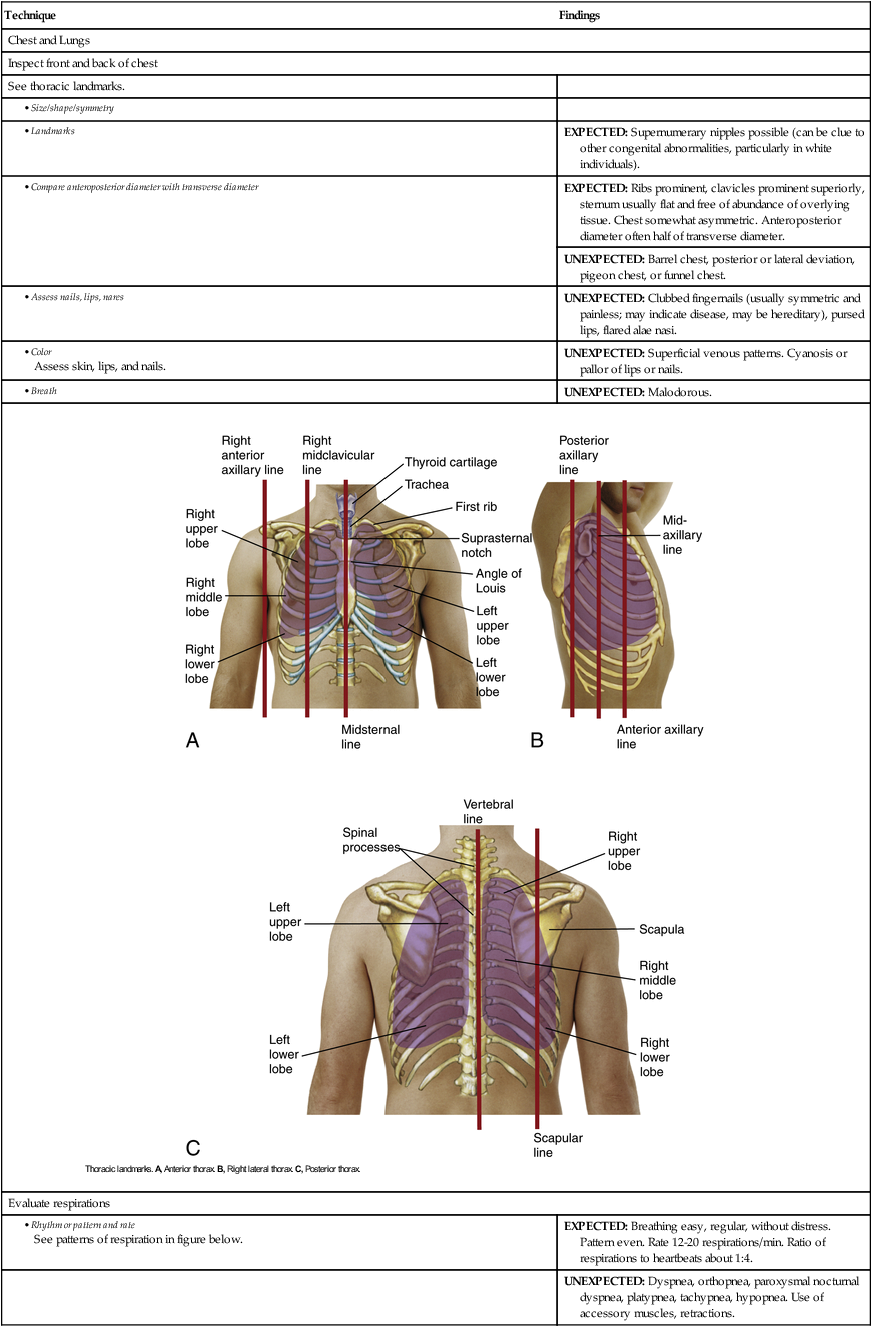
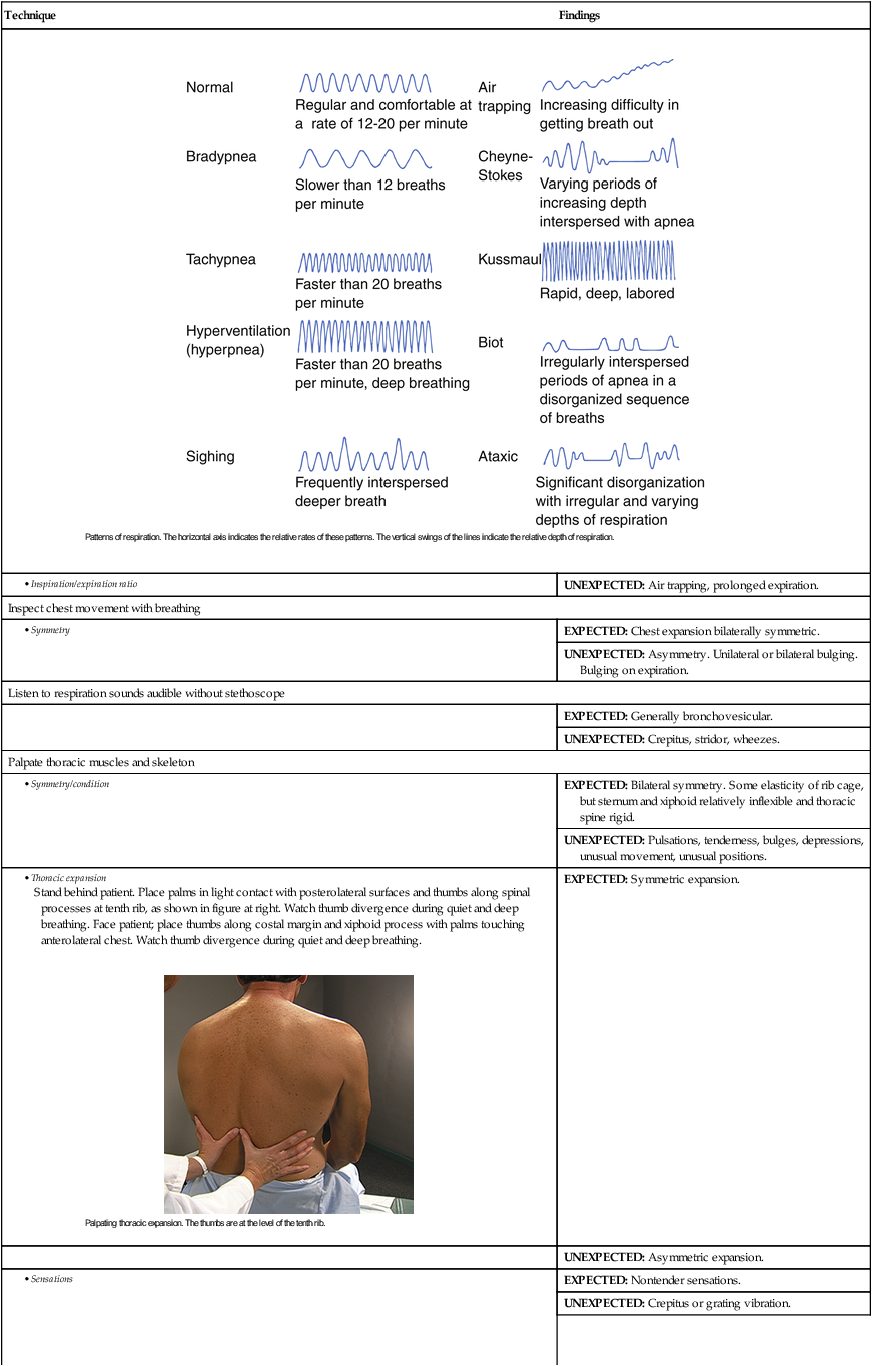
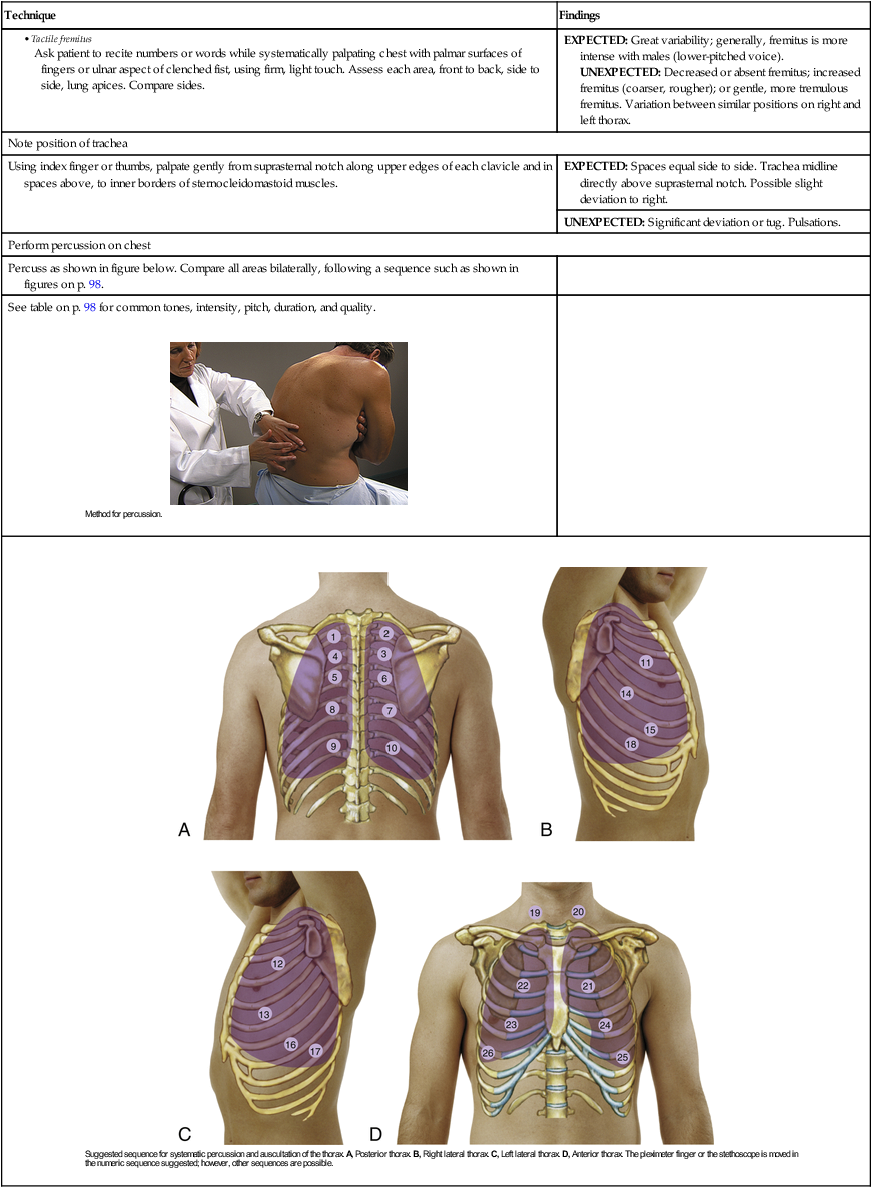
Percussion Tones Heard Over the Chest
| Type of Tone | Intensity | Pitch | Duration | Quality |
| Resonant | Loud | Low | Long | Hollow |
| Flat | Soft | High | Short | Extremely dull |
| Dull | Medium | Medium-high | Medium | Thud-like |
| Tympanic | Loud | High | Medium | Drum-like |
| Hyperresonant∗ | Very loud | Very low | Longer | Booming |

∗Hyperresonance is unexpected in adults. It represents air trapping, which occurs in obstructive lung diseases.
| Technique | Findings |
|
Have patient sit with head bent and arms folded in front while percussing posterior thorax, then with arms raised overhead while percussing lateral and anterior chest. Percuss at 4- to 5-cm intervals over intercostal spaces, moving superior to inferior, medial to lateral. The female breast may obscure findings. You or the patient may need to shift the breast, but pay careful attention to modesty. |
EXPECTED: Resonance over all areas of lungs, dull over heart and liver, spleen, areas of thorax. |
| UNEXPECTED: Hyperresonance, dullness, or flatness. | |
|
Ask patient to breathe deeply and hold breath. Percuss along scapular line on one side until tone changes from resonant to dull. Mark skin. Allow patient to breathe normally, then repeat on other side. Have patient take several breaths, then exhale as much as possible and hold. On each side, percuss up from mark to change from dull to resonant. Tell patient to resume breathing comfortably. Measure excursion distance. |
EXPECTED: 3-5 cm (higher on right than left). |
| UNEXPECTED: Limited descent. | |
| Auscultate chest with stethoscope diaphragm, apex to base | |
|
• Intensity, pitch, duration, and quality of breath sounds Have patient breathe slowly and deeply through mouth. Follow set auscultation sequence, holding stethoscope as shown in figure below. (1) with head bent and arms folded in front while auscultating posterior thorax. (2) with arms raised overhead while auscultating lateral chest. (3) with arms down and shoulders back while auscultating anterior chest. Listen during inspiration and expiration. Auscultate downward from apex to base at intervals of several centimeters, making side- to-side comparisons. |
EXPECTED: See expected breath sounds in table on p. 101. |
| UNEXPECTED: Amphoric or cavernous breathing. Sounds difficult to hear or absent. Crackles, rhonchi, wheezes, or pleural friction rub, as described in box on pp. 101-102. | |
| EXPECTED: Muffled and indistinct sounds. | |
| UNEXPECTED: Bronchophony, whispered pectoriloquy, or egophony. | |
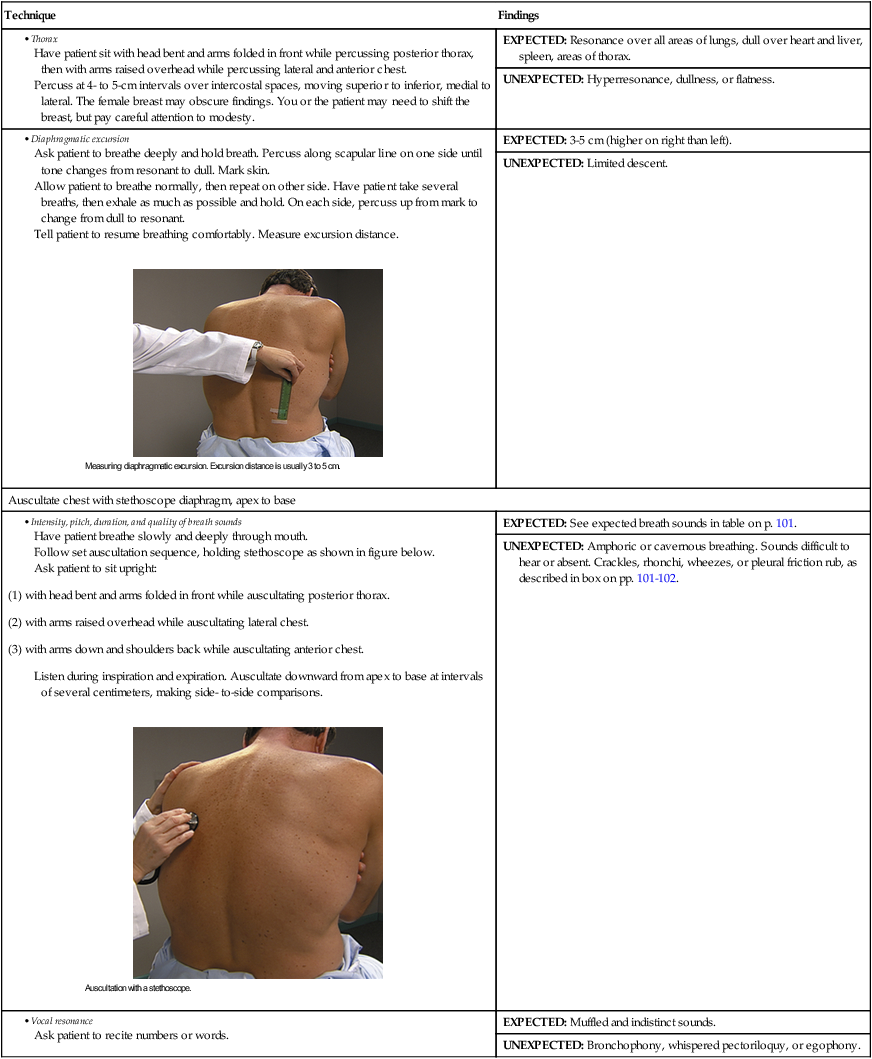
Characteristics of Expected Breath Sounds
| Sound | Characteristics | Findings |
| Vesicular | Heard over most of lung fields; low pitch; soft and short expirations; will be accentuated in a thin person or a child and diminished in overweight or very muscular patient. |  |
| Bronchovesicular | Heard over main bronchus area and over upper right posterior lung field; medium pitch; expiration equals inspiration. |  |
| Bronchotracheal (tubular) | Heard only over trachea; high pitch; loud and long expirations, often somewhat longer than inspiration. |  |

| Fine crackles: High-pitched, discrete, discontinuous crackling sounds heard during end of inspiration; not cleared by cough. |  |
| Medium crackles: Lower, more moist sound heard during midstage of inspiration; not cleared by cough. |  |
| Coarse crackles: Loud, bubbly noise heard during inspiration; not cleared by cough. |  |
| Rhonchi (sonorous wheeze): Loud, low, coarse sounds, like a snore, most often heard continuously during inspiration or expiration; coughing may clear sound (usually means mucus accumulation in trachea or large bronchi). |  |
| Wheeze (sibilant wheeze): Musical noise sounding like a squeak; most often heard continuously during inspiration or expiration; usually louder during expiration. |  |
| Pleural friction rub: Dry rubbing or grating sound, usually caused by inflammation of pleural surfaces; heard during inspiration or expiration; loudest over lower lateral anterior surface. |  |
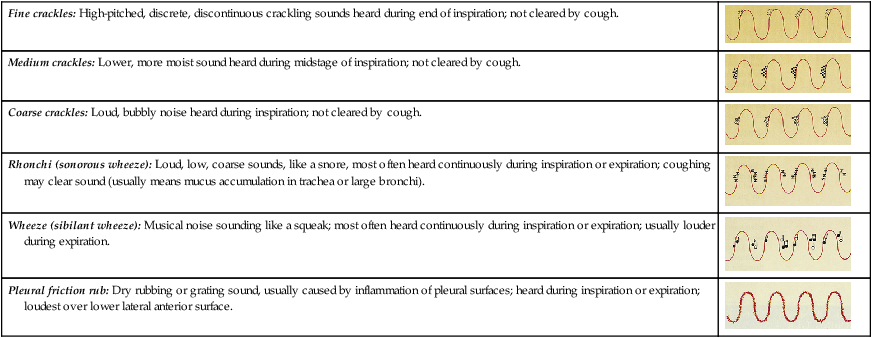
AIDS TO DIFFERENTIAL DIAGNOSIS
| Subjective Data | Objective Data |
| Pleural Effusion | |
| Cough with progressive dyspnea is the typical presenting concern. Pleuritic chest pain occurs with an inflammatory effusion. | Findings on auscultation and percussion vary with the amount of fluid present and with the position of the patient. These include dullness to percussion and tactile fremitus, which are the most useful findings for pleural effusion. When the fluid is mobile it will gravitate to the most dependent position. In the affected areas, the breath sounds are muted and the percussion note is often hyperresonant in the area above the perfusion. |
| Lung Cancer | |
| Cough, wheezing, a variety of patterns of emphysema and atelectasis, pneumonitis, and hemoptysis. Peripheral tumors without airway obstruction may be asymptomatic. | Findings are based on the extent of the tumor and the patterns of its invasion and metastasis. With airway obstruction a postobstructive pneumonia can develop with consolidation. A malignant pleural effusion may develop with corresponding findings. |
| Pneumonia | |
| Rapid onset (hours to days) of cough, pleuritic chest pain, and dyspnea. Sputum production is common with bacterial infection (see table on p. 104). Chills, fever, rigors, and nonspecific abdominal symptoms of nausea and vomiting may be present. Involvement of the right lower lobe can stimulate the tenth and eleventh thoracic nerves to cause right lower quadrant pain and simulate an abdominal process. | Febrile, tachypneic, and tachycardic. Crackles and rhonchi are common with diminished breath sounds. Egophony, bronchophony, and whisper pectoriloquy. Dullness to percussion occurs over the area of consolidation. |
| Asthma | |
| Episodes of paroxysmal dyspnea and cough. Chest pain is common and, with it, a feeling of tightness. Episodes may last for minutes, hours, or days. May be asymptomatic between episodes. | Tachypnea with wheezing on expiration and inspiration. Expiration becomes more prolonged with labored breathing, fatigue, and anxious expression as airway resistance increases. Hypoxemia by pulse oximetry. |
| Chronic Bronchitis | |
| Dyspnea may be present, although not severe. Cough and sputum production are impressive. | Wheezing and crackles. Hyperinflation with decreased breath sounds and a flattened diaphragm. Severe chronic bronchitis may result in right ventricular failure with dependent edema. |
| Emphysema | |
| Dyspnea is common even at rest. Cough is infrequent without much production of sputum. | Chest may be barrel-shaped, and scattered crackles or wheezes may be heard. Overinflated lungs are hyperresonant on percussion. Inspiration is limited with a prolonged expiratory effort (i.e., >4 or 5 sec) to expel air. |
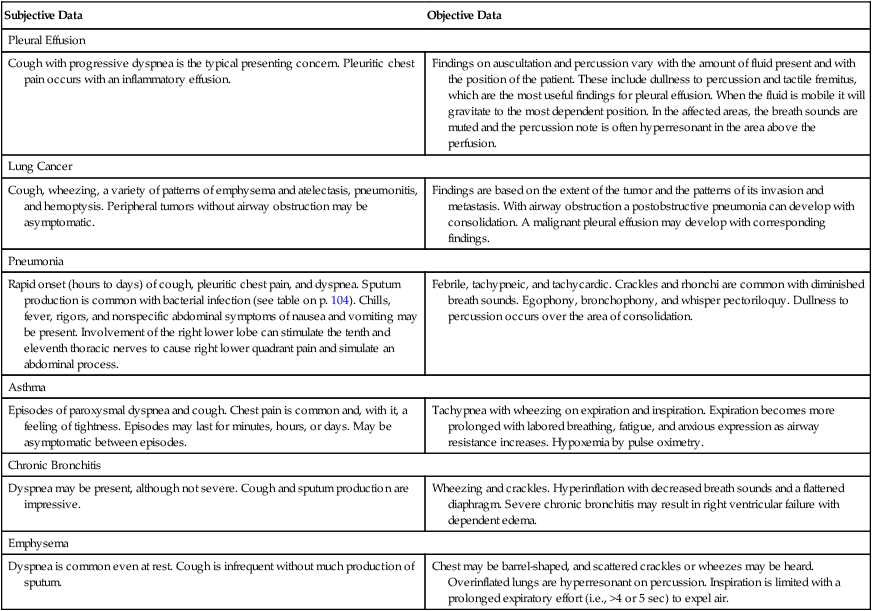
| Cause | Possible Sputum Characteristics |
| Bacterial infection | Yellow, green, rust-colored (blood mixed with yellow sputum), clear, or transparent; purulent; blood streaked; mucoid, viscid |
| Viral infection | Mucoid, viscid; blood streaked (not common) |
| Chronic infectious disease | All of the above; particularly abundant in early morning; slight, intermittent blood streaking; occasionally large amounts of blood |
| Carcinoma | Slight, persistent blood streaking |
| Infarction | Blood clotted; large amounts of blood |
| Tuberculous cavity | Large amounts of blood |
PEDIATRIC VARIATIONS
EXAMINATION
| Technique | Findings | |
| Chest and Lungs | ||
| Inspect front and back of chest | ||
| EXPECTED: Infant’s chest is expected to measure 2-3 cm less than head circumference. | ||
| Evaluate respirations | ||
| EXPECTED: | ||
| Age | Respirations per Minute | |
| Newborn | 30-80 | |
| 1 yr | 20-40 | |
| 3 yr | 20-30 | |
| 6 yr | 16-22 | |
| 10 yr | 16-20 | |
| 17 yr | 12-20 | |
| Perform direct or indirect percussion on chest | ||
| EXPECTED: Hyperresonance may be heard in children. | ||
| Auscultate chest with stethoscope diaphragm, apex to base | ||
| EXPECTED: In infants and children, expect transmitted breath sounds throughout chest. Vesicular sound is accentuated in a child. Absent or diminished breath sounds are harder to detect. | ||
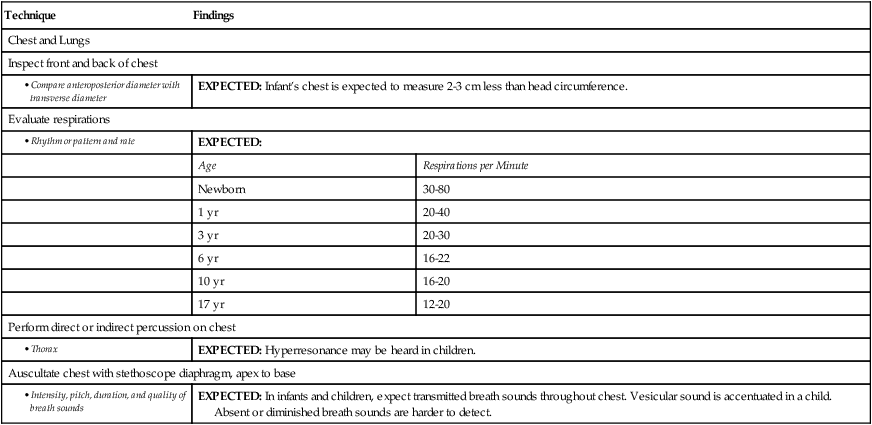
Sample Documentation
Subjective
A 45-year-old woman presents with cough and fever for 4 days. Cough is nonproductive, persistent, and worse when she lies down. She feels ill and short of breath. Her chest feels “heavy.” Fever up to 38.3° C (101° F). Taking acetaminophen and nonprescription cough syrup without relief.
Objective
Pulse 104 per minute, temperature 38.2° C, blood pressure 122/82, respirations 32 per minute and somewhat labored; no retractions or stridor. Minimal increase in anteroposterior diameter of chest, without kyphosis or other defect. Trachea in midline without tug. Thoracic expansion symmetric. No friction rubs or tenderness over ribs or other bony prominences. Over posterior left base, diminished tactile fremitus, dull percussion note, and on auscultation, crackles that do not clear with cough, diminished breath sounds. Remaining lung fields are clear and free of adventitious sounds, with resonant percussion tones. Diaphragmatic excursion 3 cm bilaterally.
